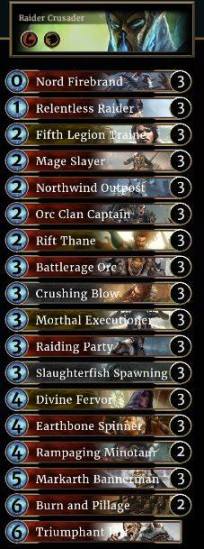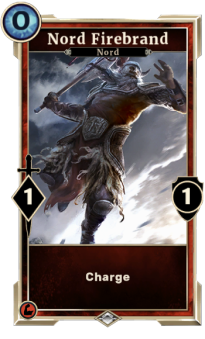Don’t Raid On My Crusade – CoreyMilhouse
Before September’s Monthly Reward Card, Hist Grove, was introduced into the meta, Control Mages and other Mantikora decks kept Scout Ramp decks in check. Now, with the changes to Mantikora, Control Mage has taken a back seat to the new late-game deck in town: Hist Grove Ramp.
When looking at the decks of the TES:L metagame, Scout always qualified as a control deck for me. However, its matchups didn’t really make sense for a control deck, since it performed well against Midrange strategies, went about 50/50 against aggressive strategies, and struggled against Control Mage, the premier control deck of the format. However, you’d look at Control Mage’s matchups, which were favorable against Aggro, and unfavorable against most Midrange decks like Archer.
The Scout Ramp decks began to change shape, as playing Tree Minder now became necessary to be able to have a strong Hist Grove plan. Most lists, in order to fit these cards into their 50-card lists, began cutting cards like Young Mammoth and House Kinsman – two cards that are great against aggressive stregies. However, in doing so, their late-game potential sky-rocketed.
Many players, including myself, began to notice this shift in the Scout decks. Tree Minder is good at ramping you in Magicka, but awful at trying to stave off an aggressive start and remove threats from the board. Aggressive strategies have begun to rise to the top of the ladder as a result, and I’m here to talk about a list I have been playing that I like to call “Raider Crusader.”

CoreyMilhouse’s Raider Crusader
The Rise of Markarth Bannerman
Markarth Bannerman has been criminally underplayed to this point, since the 5-Magicka slot is highly contested in so many decks. Most times, it just eats a Lightning Bolt, you get no value out of your five Magicka, and your opponent even gets to use only four Magicka to deal with it. But what if you are deploying threat after threat before you play it, and your opponent has run out of reactive cards to deal with it? Most likely scenario? Bannerman wins you the game by itself.
Combined with cards like Fifth Legion Trainer, Northwind Outpost, Orc Clan Captain, and Divine Fervor, Markarth Bannerman  becomes an army of one.
becomes an army of one.
Much like Bannerman, Raiding Party has seen a rise in popularity, as two bodies for one card (and with Charge) is a very strong effect for three Magicka. We’ve seen the combination of these two cards do some powerful things in combination with Supreme Atromancer in s_l_w’s Combo Battlemage deck, but what if we took a more aggressive approach to using this combination to win games?
Raider Crusader is then born.
Charge is Powerful
There is a reason why there are very, very few cards in this game that give a creature charge. In a game where you are able to directly attack your opponent’s life total AND their creates, Charge is, in my opinion, the most powerful keyword in the game. Think about all of the times your opponent got Charge on some enormous creature via Mundus Stone – wasn’t very fun, was it? Or all of the times you’ve lost to Tazkad? Yeah, 6/6 with Charge is really strong!
Battlerage Orc and Rampaging Minotaur are the two cards in this deck that are the “fair” charge cards, because they cost 3 and 4 Magicka respectively. However, it’s the 1/1 Nord Firebrands that are the all-stars of Raider Crusader. They aren’t particularly powerful on their own, but combined with the rest of the supporting cast of the deck, you can deal massive amounts of damage out of nowhere.
Making Nords Huge
In order to take advantage of zero Magicka 1/1 Charge creatures, you need ways to make them attack for more than 1 damage. This deck has absolutely no shortage of that, with cheap “buffs” like Fifth Legion Trainer, Orc Clan Captain, and Northwind Outpost. In addition, the ever-popular token card Divine Fervor is played in this list to provide more power and toughness to the Nords, and  everything else in the deck, too.
everything else in the deck, too.
The deck has a focus around Strength creatures to be able to take advantage of Northwind Outpost as much as possible. This is why you don’t see cards like Scouting Patrol, Imperial Reinforcements, and other cards that really don’t have synergy with the deck’s strategies as much. The games you will win with this deck are primarily going to be with Nord tokens being buffed up and bursting down your opponent, and that was the primary plan the deck was built around.
Plan B
Raider Crusader has a few “Plan B” cards, or other cards that help in dealing more damage – the first being Relentless Raider itself. I cut Scouting Patrol for this card because of how many times a Fighter’s Guild Recruit or Thieves Guild Recruit would take out half of my card, and then still leave behind a 1/1 to continue to trade with other cards I played. Relentless Raider allows you to both have 2 power on board on turn 1 if you choose, but also has the ability to contribute to 2, 3, or 4 damage later in the game when breaking runes.
Similar to Relentless Raider, Morthal Executioner provides a resilient body with 4 toughness on a 3 Magicka creature, and can start attacking for a ton of damage by itself. Slaughterfish Spawning serves a similar purpose, as a “must-answer” threat that continues to grow the more it is not dealt with.
The single Triumphant Jarl is a nod to the amount of times you can run out of gas with the deck, and I have been the happiest with a single copy so far. Jarl and Burn and Pillage are really your “Plan C”, to try and dig yourself out of a game if you haven’t yet secured a victory by turn seven or later.
Good and Bad Matchups
Prophecy Assassin is pretty much Public Enemy #1 for this deck, as the high density of Prophecies combined with cards like House Kinsman and Moonlight Werebat can make racing completely impossible at times. The deck has access to Lightning Bolt to easily deal with Bannerman, and can prey on a deck with no Prophecies such as Raider Crusader. However, there are no Prophecies in  Crusader that I would consider would be worth adding to the deck, so this just ends up being a matchup you have to struggle against.
Crusader that I would consider would be worth adding to the deck, so this just ends up being a matchup you have to struggle against.
Slower decks such as Scout Ramp are a relatively good matchup for the deck, as well as Archer being one of the easier decks to beat. Their strategy relies on cards like Soulrest Marshal and Triumphant Jarl, which end up doing nothing due to Archer having to play from behind the majority of the game.
Most players refuse to play a deck like Raider Crusader due to Moonlight Werebat, and I find that to be completely silly. If you are prepared for a Werebat, either from hand or from a Prophecy, the game is not over. I have won multiple games against a first-rune Prophecy Werebat, and have also won a handful against multiple Prohpecy Werebats. Prioritize your Crushing Blows early against them, and also learn how to play into situations where you can throw a Nord at one for 3 damage to take it out.
Overall, I have really enjoyed playing this deck, as it has a bit of a “combo” feel to it compared to other Aggro decks, and has had some of the most complex lines of play for an aggressive deck. I feel this deck will be here to stay until people begin to play more life-gain in their decks, and the meta will once again shift from there.
_____________________________________________________________
Follow CoreyMilhouse on Twitch to catch his Legends stream!

 Why the glum look, friend? $cout decks got you down? Can't contend with their late game now that Hist Grove has been introduced to the meta? Well, cheer up, young buck! It's time to play some zero Magicka creatures!
Why the glum look, friend? $cout decks got you down? Can't contend with their late game now that Hist Grove has been introduced to the meta? Well, cheer up, young buck! It's time to play some zero Magicka creatures!
Hi CoreyMilhouse, just tried your deck. Lost five games in a row….
LikeLike
just lost six games in a row with this deck on rank 2
LikeLike